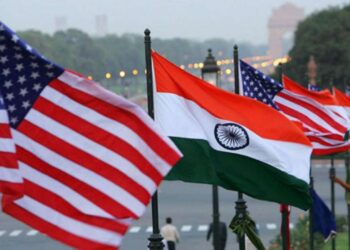The United States has issued a fresh travel advisory cautioning its citizens against travelling to areas close to the India-Pakistan border, as well as certain regions within Pakistan. The advisory comes in response to ongoing security threats, including terrorism, armed conflict, and potential risks to foreign nationals. The US government has urged travellers to exercise extreme caution and avoid unnecessary trips to these high-risk areas.
US Travel Advisory: Key Areas of Concern
The advisory highlights specific locations where security risks remain high due to ongoing militant activities, cross-border tensions, and potential terrorist threats.
Pakistan: Reconsider Travel Due to Terrorism and Armed Conflict
The US government has recommended that its citizens reconsider travel to Pakistan, particularly in areas prone to terrorist attacks and political unrest. The advisory identifies the following high-risk regions:
- Balochistan Province – The region has witnessed frequent attacks by insurgent groups, with growing security concerns over kidnappings and targeted violence.
- Khyber Pakhtunkhwa Province – This area, which includes the former Federally Administered Tribal Areas (FATA), has been a hotspot for terrorist activities, posing a significant risk to travellers.
- India-Pakistan Border – The advisory specifically mentions the risk of violence along the border, including near the Line of Control (LoC) in Jammu and Kashmir.
These regions are particularly vulnerable to extremist activities, with armed groups targeting civilians, security forces, and infrastructure. The US has warned its citizens to avoid these locations unless necessary.
Why the US Has Issued This Advisory
The primary reason behind the advisory is the persistent security threat posed by militant groups operating in these regions. There has been a rise in violent incidents targeting both locals and foreign nationals. The risks include:
Terrorist Threats and Attacks
Terrorist organisations in Pakistan continue to pose a significant danger, with ongoing plots to target public places, government institutions, and foreign nationals. The advisory warns that attacks could be indiscriminate and may occur without prior warning. Public spaces such as markets, shopping centres, and places of worship are common targets.
Armed Conflict and Border Tensions
The India-Pakistan border remains a sensitive and volatile area. The Line of Control (LoC) in Jammu and Kashmir has seen repeated cross-border skirmishes, making the region unsafe for travel. The presence of military forces and militant groups has heightened tensions, leading to an unpredictable security environment.
Kidnapping and Violence
Incidents of kidnapping, particularly in Pakistan’s Balochistan and Khyber Pakhtunkhwa provinces, have been reported. Criminal groups and insurgents often target foreigners for ransom or political leverage. The US government advises against travel to these areas due to the high risk of abduction.
Security Situation in the Region
The security situation in both Pakistan and the India-Pakistan border region remains fluid, with the potential for rapid escalation. While major cities such as Islamabad and Lahore have relatively stronger security infrastructure, the risk of attacks remains present. In remote areas, especially those near conflict zones, security forces struggle to maintain stability, making them particularly dangerous for travellers.
The advisory highlights that even areas considered relatively stable can become high-risk zones without warning. Previous incidents have demonstrated how terrorist groups have been able to bypass security measures and execute attacks in urban centres.
Precautions for US Citizens and Other Foreign Travellers
In light of the travel advisory, US citizens planning to visit Pakistan or regions near the India-Pakistan border are urged to take the following precautions:
- Avoid Non-Essential Travel – The advisory strongly discourages unnecessary trips to high-risk regions. Even if visiting major cities, it is important to remain aware of potential threats.
- Stay Informed – Travellers should monitor updates from the US Embassy and local authorities for real-time information on security conditions.
- Exercise Increased Vigilance – Public spaces, transport hubs, and large gatherings should be approached with caution, as they are common targets for attacks.
- Register Travel Plans – The US State Department’s Smart Traveler Enrollment Program (STEP) allows travellers to receive alerts and assistance if necessary.
- Have an Emergency Plan – In case of an unexpected security threat, having a clear evacuation strategy is essential. This includes knowing the nearest embassy or consulate and staying in secure accommodation.

Impact of the Advisory on Travel and Diplomatic Relations
The US travel advisory is likely to affect travel plans for both tourists and business travellers with interests in South Asia. While Pakistan and India remain popular destinations for heritage tourism, cultural exploration, and trade, heightened security concerns may discourage foreign visitors.
For businesses operating in Pakistan, the advisory serves as a reminder of the potential risks involved in conducting operations in volatile regions. International companies may need to reassess their security protocols, particularly if they have offices or investments in high-risk areas.
Additionally, the travel advisory could impact diplomatic relations between the US and South Asian nations. Pakistan has often contested international travel warnings, arguing that they negatively affect its global image and economic prospects. However, security experts maintain that such advisories are necessary to protect foreign nationals from potential harm.
Comparisons with Past Travel Advisories
This is not the first time the US has issued travel warnings regarding South Asia. Previous advisories have highlighted similar security risks, particularly in areas affected by terrorism and border conflicts. However, the latest warning reflects an ongoing and evolving threat landscape.
Historically, US travel advisories for Pakistan have focused on terrorism and political instability, while those for India have primarily addressed border tensions with Pakistan. The latest advisory reinforces the need for vigilance and underscores the persistent security concerns in the region.
Final Thoughts
The US government’s travel advisory serves as a crucial reminder of the ongoing security challenges in South Asia. Travellers must exercise caution and avoid regions with heightened risks, particularly near the India-Pakistan border and certain areas of Pakistan.
While some may see these warnings as a precautionary measure, they reflect the reality of an unpredictable security landscape. Those planning to visit affected areas should take all necessary precautions, stay updated on developments, and prioritise safety above all else.










